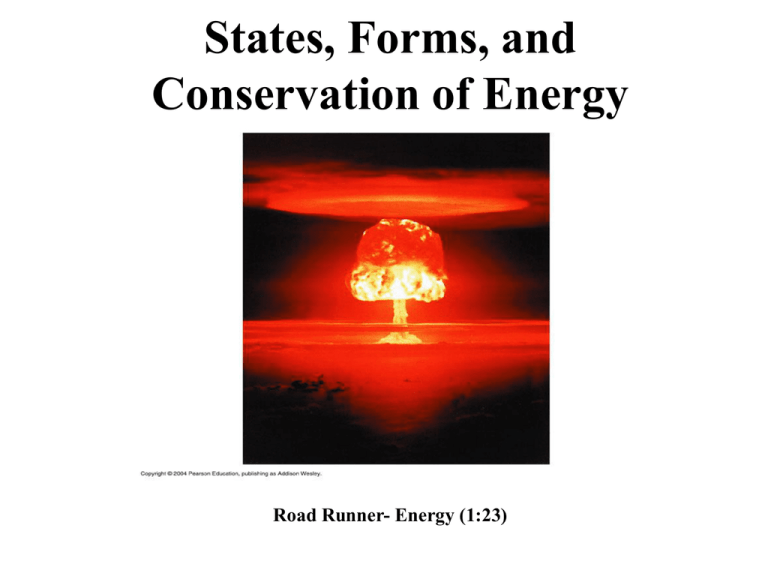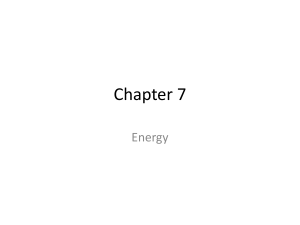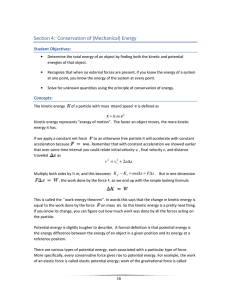States, Forms, and Conservation of Energy Road Runner- Energy (1:23)
advertisement

States, Forms, and Conservation of Energy Road Runner- Energy (1:23) • energy is the ability to do work – unit of measurement is also the Joule (J) – Kinetic and Potential Energy (1:55) STATES of Energy • Kinetic Energy – energy of motion – a moving object has the ability to do work • this depends on the object’s mass and velocity Kinetic Energy formula K.E. = m · 2 2 v K.E. = Kinetic Energy m = mass v = velocity Example problem • How much kinetic energy is in a 5 kg ball with a velocity of 7 m/s? given m = 5kg v = 7m/s formula KE= m · v2 2 set up problem answer w/ unit of measurement 5kg(7m/s)2 2 or kg(m/s)2 122.5 Joules – Potential Energy • stored energy • objects can have energy (can do work) because of their Position or Make Up – a stretched rubber band (P) – a can of gasoline (MU) – an object that is held up and can fall (P) Gravitational Potential Energy Formula gravitational PE = m · g · h PE = Potential Energy m = mass g = acceleration due to gravity on earth (9.8 m/s2) h = height Potential Energy mass of object (kg) height object raised (m) PE (joules) EP = mgh gravity (9.8 m/sec2) Slinky Falling YouTube (first 1:40) Example problem • What is a gravitational potential energy of a 5 kg brick 4 meters high? given formula set up problem answer w/ unit of measurement m = 5kg PE= mgh 5kg · 9.8m/s2 · 4m g = 9.8m/s2 h=4m or kg(m/s2)(m) 196 Joules FORMS of Energy (these can be kinetic or potential) 1. Mechanical Energy – energy possessed by an object that has to do with motion Forms of Energy (1:59) 2. Radiant Energy – carried by waves (micro, heat, UV, x-ray…) 3. Chemical Energy – – energy stored in molecules can be released when the molecules are broken apart • burning fuel, photosynthesis, digesting food… http://phet.colorado.edu/en/simulation/nucle ar-fission 4. Nuclear Energy – – a very concentrated form of energy results when the nucleus of an atom splits (fisson) or two nuclei join (fusion) 5. Electrical Energy – energy from moving electrons Law of Conservation of Energy • energy cannot be created nor destroyed by ordinary means • in a closed system, it is not “used up” but just converted to another form and therefore remains constant • we can never “run out” of energy – however, may run out of the type we want the most Converting Energy • all forms of energy can be converted to other forms – sometimes simply PE to KE and back to PE – or more complicated like mechanical, heat, chemical, electric, electromagnetic, and nuclear • example: the chemical energy from the gas in a car changes into mechanical and radiant energy as the car moves. What energy transformations must happen to light a light bulb? mechanical energy from the water in a river moves a turbine in a dam that makes…electrical energy in the light bulb that changes to…radiant energy and light energy that we can see and feel Law of Conservation of Energy video (1:41) PE/KE Skate Park Pendulum




